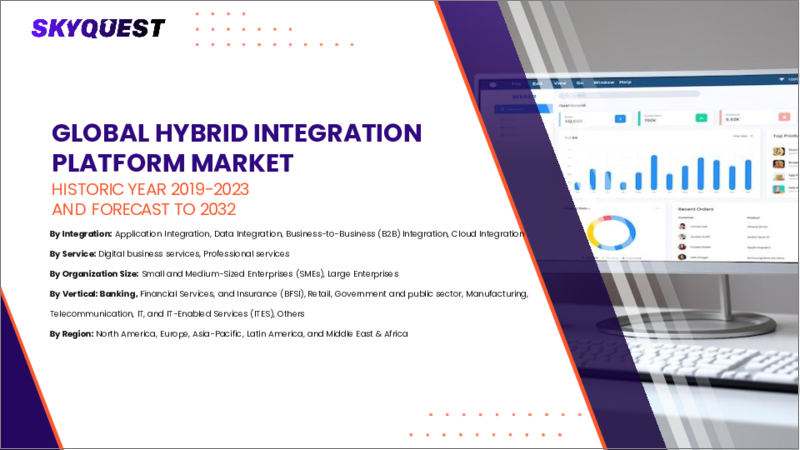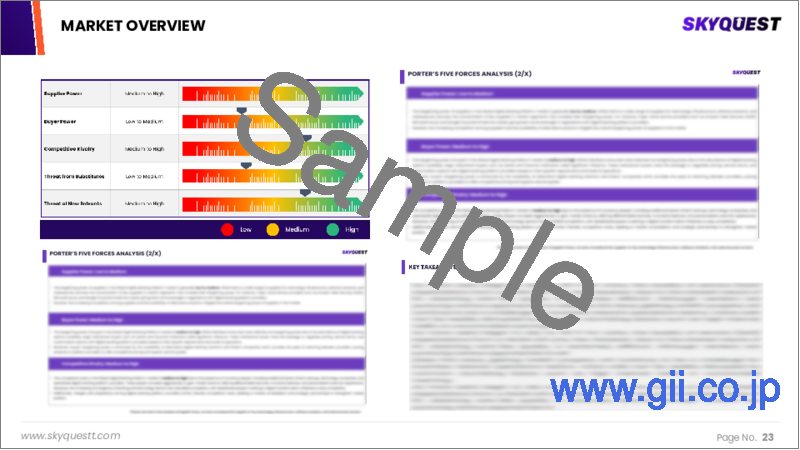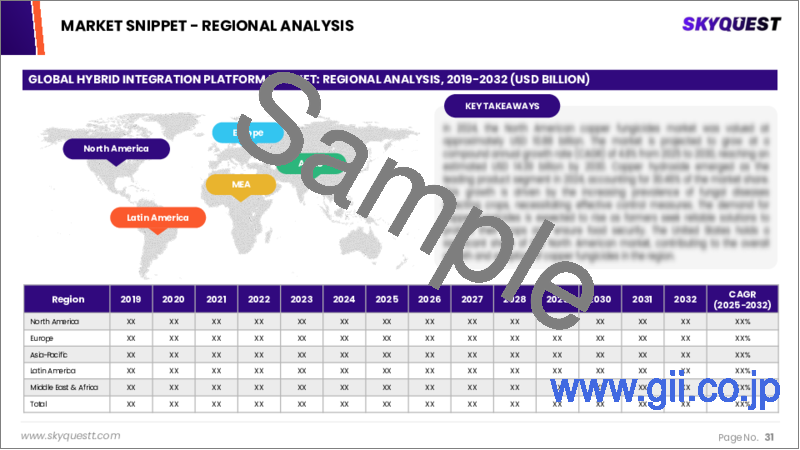|
|
市場調査レポート
商品コード
1630608
ハイブリッド統合プラットフォーム市場規模、シェア、成長分析、統合タイプ別、サービスタイプ別、組織規模別、業界別、地域別 - 産業予測、2025-2032年Hybrid Integration Platform Market Size, Share, Growth Analysis, By Integration Type, By Service Type, By Organization Size, By Vertical, By Region - Industry Forecast 2025-2032 |
||||||
|
|||||||
| ハイブリッド統合プラットフォーム市場規模、シェア、成長分析、統合タイプ別、サービスタイプ別、組織規模別、業界別、地域別 - 産業予測、2025-2032年 |
|
出版日: 2025年01月07日
発行: SkyQuest
ページ情報: 英文 195 Pages
納期: 3~5営業日
|
全表示
- 概要
- 目次
ハイブリッド統合プラットフォームの世界市場規模は2023年に347億米ドルとなり、予測期間(2025-2032年)のCAGRは15.1%で、2024年の399億4,000万米ドルから2032年には1,230億3,000万米ドルに成長する見通しです。
世界の産業用ハイブリッド統合プラットフォーム(HIP)市場は、産業のデジタル化を強化することを目的とした様々な分野でのクラウドベースのソリューション採用の高まりに後押しされ、大幅な成長を遂げています。効率性と柔軟性を向上させるためのデジタル・イニシアティブに対する政府の多額の投資も、この動向に寄与しています。クラウド環境におけるネットワーキングとデータ・セキュリティへの懸念が拍車をかけ、企業はクラウドとオンプレミス・アプリケーションの統合をますます優先するようになっています。この需要は、デジタルトランスフォーメーションへのシフト、ホスティングサービスの必要性、IoTデバイスの統合によるリアルタイムの意思決定によってさらに高まっています。さらに、HIPはコスト削減、プロセスの合理化、複雑性の軽減など多くの利点を提供し、企業が業務を近代化し、サービスとしてのソフトウェアを採用することで成長への道を開いています。
目次
イントロダクション
- 調査の目的
- 調査範囲
- 定義
調査手法
- 情報調達
- 二次データと一次データの方法
- 市場規模予測
- 市場の前提条件と制限
エグゼクティブサマリー
- 世界市場の見通し
- 供給と需要の動向分析
- セグメント別機会分析
市場力学と見通し
- 市場概要
- 市場規模
- 市場力学
- 促進要因と機会
- 抑制要因と課題
- ポーターの分析
主な市場の考察
- 重要成功要因
- 競合の程度
- 主な投資機会
- 市場エコシステム
- 市場の魅力指数(2024年)
- PESTEL分析
- マクロ経済指標
- バリューチェーン分析
- 価格分析
- ケーススタディ分析
ハイブリッド統合プラットフォーム市場規模:統合タイプ別
- 市場概要
- アプリケーション統合
- データ統合
- B2B統合
- クラウド統合
ハイブリッド統合プラットフォーム市場規模:サービスタイプ別
- 市場概要
- デジタルビジネスサービス
- データ統合ツール
- アプリケーションプログラミングインターフェース管理
- サービスとしての統合プラットフォーム
- マネージドファイル転送
- エンタープライズサービスバス
- サービスとしてのソフトウェア
- エンドポイント統合
- 通信ゲートウェイサービス
- B2Bゲートウェイ
- メッセージ指向ミドルウェア
- プロフェッショナルサービス
- トレーニングとコンサルティング
- サポートとメンテナンス
ハイブリッド統合プラットフォーム市場規模:組織規模別
- 市場概要
- 中小企業
- 大企業
ハイブリッド統合プラットフォーム市場規模:業界別
- 市場概要
- BFSI
- 小売り
- 政府および公共部門
- 製造業
- 通信、IT、ITE
- その他
ハイブリッド統合プラットフォーム市場規模
- 北米
- 米国
- カナダ
- 欧州
- ドイツ
- スペイン
- フランス
- 英国
- イタリア
- その他欧州地域
- アジア太平洋地域
- 中国
- インド
- 日本
- 韓国
- その他アジア太平洋地域
- ラテンアメリカ
- ブラジル
- その他ラテンアメリカ地域
- 中東・アフリカ
- GCC諸国
- 南アフリカ
- その他中東・アフリカ
競合情報
- 上位5社の比較
- 主要企業の市場ポジショニング(2024年)
- 主な市場企業が採用した戦略
- 市場の最近の動向
- 企業の市場シェア分析(2024年)
- 主要企業の企業プロファイル
- 会社概要
- 製品ポートフォリオ分析
- セグメント別シェア分析
- 収益の前年比比較(2022-2024)
主要企業プロファイル
- Software AG(Germany)
- Dell Boomi(US)
- IBM(US)
- Oracle(US)
- Snaplogic(US)
- Axway(France)
- RoboMQ(US)
- Talend Inc.(Qlik)(US)
- Flowgear(Australia)
- Seeburger AG(Germany)
結論と推奨事項
Global Hybrid Integration Platform Market size was valued at USD 34.7 billion in 2023 and is poised to grow from USD 39.94 billion in 2024 to USD 123.03 billion by 2032, growing at a CAGR of 15.1% during the forecast period (2025-2032).
The global industrial hybrid integration platform (HIP) market is experiencing substantial growth, fueled by the rising adoption of cloud-based solutions across various sectors aimed at enhancing industrial digitization. Significant government investments in digital initiatives to improve efficiency and flexibility are also contributing to this trend. Organizations are increasingly prioritizing the integration of cloud and on-premises applications, spurred by concerns over networking and data security in cloud environments. This demand is further amplified by the shift towards digital transformation, the need for hosting services, and real-time decision-making through the integration of IoT devices. Additionally, HIP offers numerous advantages, including reduced costs, streamlined processes, and decreased complexity, paving the way for growth as businesses modernize their operations and embrace software as a service.
Top-down and bottom-up approaches were used to estimate and validate the size of the Global Hybrid Integration Platform market and to estimate the size of various other dependent submarkets. The research methodology used to estimate the market size includes the following details: The key players in the market were identified through secondary research, and their market shares in the respective regions were determined through primary and secondary research. This entire procedure includes the study of the annual and financial reports of the top market players and extensive interviews for key insights from industry leaders such as CEOs, VPs, directors, and marketing executives. All percentage shares split, and breakdowns were determined using secondary sources and verified through Primary sources. All possible parameters that affect the markets covered in this research study have been accounted for, viewed in extensive detail, verified through primary research, and analyzed to get the final quantitative and qualitative data.
Global Hybrid Integration Platform Market Segmental Analysis
Global Hybrid Integration Platform Market is segmented by Integration Type, Service Type, Organization Size, Vertical and region. Based on Integration Type, the market is segmented into Application Integration, Data Integration, B2B Integration and Cloud Integration. Based on Service Type, the market is segmented into Digital Business Services and Professional Services. Based on Organization Size, the market is segmented into Small and Medium-Sized Enterprises and Large Enterprises. Based on Vertical, the market is segmented into BFSI, Retail, Government and Public Sector, Manufacturing, Telecommunication, IT, and ITEs and Others. Based on region, the market is segmented into North America, Europe, Asia Pacific, Latin America and Middle East & Africa.
Driver of the Global Hybrid Integration Platform Market
The Global Hybrid Integration Platform market is experiencing significant growth, primarily fueled by the rising adoption of hybrid cloud solutions. Organizations worldwide are leveraging cloud technologies to enhance agility, foster innovation, achieve cost efficiencies, and scale their operations while maintaining the flexibility to adapt quickly. Many companies employ multiple cloud services to meet varying operational needs; for instance, using Salesforce for customer relationship management and marketing, while relying on AWS for development purposes. Additionally, sectors such as finance and healthcare are increasingly turning to hybrid models, blending public infrastructures with private cloud solutions to comply with stringent regulatory standards and ensure robust data protection.
Restraints in the Global Hybrid Integration Platform Market
The Global Hybrid Integration Platform market faces notable restraints due to the rising concerns surrounding cybersecurity threats. Organizations leveraging hybrid integration platforms are increasingly vulnerable to sophisticated cyber-attacks, including malware, ransomware, phishing schemes, and insider threats, all of which exploit weaknesses within the infrastructure to access sensitive information, disrupt business operations, and incur financial losses. To mitigate these risks, it is essential for companies to implement comprehensive cybersecurity strategies that encompass threat detection, vulnerability management, and effective incident response protocols. Consequently, these cybersecurity challenges may hinder the growth and adoption of hybrid integration platforms in the market.
Market Trends of the Global Hybrid Integration Platform Market
The global hybrid integration platform market is witnessing significant growth, driven by the rising necessity to seamlessly connect on-premises and cloud applications to facilitate digital business transformation. As organizations increasingly migrate to cloud-based services, the demand for hybrid integration solutions is surging. Companies are leveraging these platforms to navigate operational challenges and ensure compliance, further propelling market expansion. Additionally, the integration of end-to-end IoT devices with enterprise applications presents a valuable opportunity for growth in the coming years, as businesses aim to enhance connectivity and automate processes, ultimately transforming their operational landscapes more efficiently.
Table of Contents
Introduction
- Objectives of the Study
- Scope of the Report
- Definitions
Research Methodology
- Information Procurement
- Secondary & Primary Data Methods
- Market Size Estimation
- Market Assumptions & Limitations
Executive Summary
- Global Market Outlook
- Supply & Demand Trend Analysis
- Segmental Opportunity Analysis
Market Dynamics & Outlook
- Market Overview
- Market Size
- Market Dynamics
- Drivers & Opportunities
- Restraints & Challenges
- Porters Analysis
- Competitive rivalry
- Threat of substitute
- Bargaining power of buyers
- Threat of new entrants
- Bargaining power of suppliers
Key Market Insights
- Key Success Factors
- Degree of Competition
- Top Investment Pockets
- Market Ecosystem
- Market Attractiveness Index, 2024
- PESTEL Analysis
- Macro-Economic Indicators
- Value Chain Analysis
- Pricing Analysis
- Case Study Analysis
Global Hybrid Integration Platform Market Size by Integration Type & CAGR (2025-2032)
- Market Overview
- Application Integration
- Data Integration
- B2B Integration
- Cloud Integration
Global Hybrid Integration Platform Market Size by Service Type & CAGR (2025-2032)
- Market Overview
- Digital Business Services
- Data Integration Tools
- Application Programming Interface Management
- Integration Platform as A Service
- Managed File Transfer
- Enterprise Service Bus
- Software as A Service
- Endpoint Integration
- Communication Gateway Services
- B2B Gateway
- Message-Oriented Middleware
- Professional Services
- Training and Consulting
- Support and Maintenance
Global Hybrid Integration Platform Market Size by Organization Size & CAGR (2025-2032)
- Market Overview
- Small and Medium-Sized Enterprises
- Large Enterprises
Global Hybrid Integration Platform Market Size by Vertical & CAGR (2025-2032)
- Market Overview
- BFSI
- Retail
- Government and Public Sector
- Manufacturing
- Telecommunication, IT, and ITEs
- Others
Global Hybrid Integration Platform Market Size & CAGR (2025-2032)
- North America (Integration Type, Service Type, Organization Size, Vertical)
- US
- Canada
- Europe (Integration Type, Service Type, Organization Size, Vertical)
- Germany
- Spain
- France
- UK
- Italy
- Rest of Europe
- Asia Pacific (Integration Type, Service Type, Organization Size, Vertical)
- China
- India
- Japan
- South Korea
- Rest of Asia-Pacific
- Latin America (Integration Type, Service Type, Organization Size, Vertical)
- Brazil
- Rest of Latin America
- Middle East & Africa (Integration Type, Service Type, Organization Size, Vertical)
- GCC Countries
- South Africa
- Rest of Middle East & Africa
Competitive Intelligence
- Top 5 Player Comparison
- Market Positioning of Key Players, 2024
- Strategies Adopted by Key Market Players
- Recent Developments in the Market
- Company Market Share Analysis, 2024
- Company Profiles of All Key Players
- Company Details
- Product Portfolio Analysis
- Company's Segmental Share Analysis
- Revenue Y-O-Y Comparison (2022-2024)
Key Company Profiles
- Software AG (Germany)
- Company Overview
- Business Segment Overview
- Financial Updates
- Key Developments
- Dell Boomi (US)
- Company Overview
- Business Segment Overview
- Financial Updates
- Key Developments
- IBM (US)
- Company Overview
- Business Segment Overview
- Financial Updates
- Key Developments
- Oracle (US)
- Company Overview
- Business Segment Overview
- Financial Updates
- Key Developments
- Snaplogic (US)
- Company Overview
- Business Segment Overview
- Financial Updates
- Key Developments
- Axway (France)
- Company Overview
- Business Segment Overview
- Financial Updates
- Key Developments
- RoboMQ (US)
- Company Overview
- Business Segment Overview
- Financial Updates
- Key Developments
- Talend Inc. (Qlik) (US)
- Company Overview
- Business Segment Overview
- Financial Updates
- Key Developments
- Flowgear (Australia)
- Company Overview
- Business Segment Overview
- Financial Updates
- Key Developments
- Seeburger AG (Germany)
- Company Overview
- Business Segment Overview
- Financial Updates
- Key Developments





